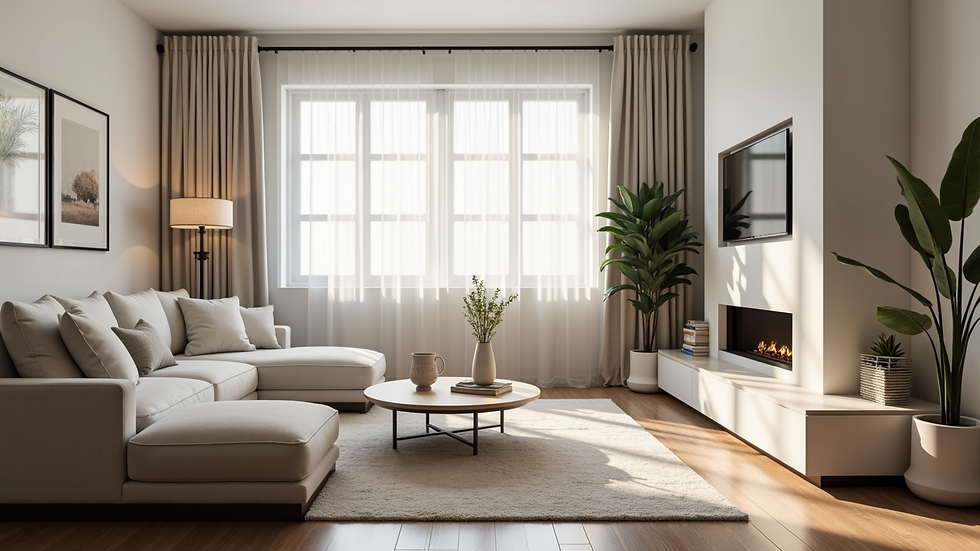Top Tips for Real Estate Staging Success
- Ashley Gold
.png/v1/fill/w_320,h_320/file.jpg)
- Sep 30
- 3 min read
Staging a home effectively can significantly influence the speed and price of a sale. I have observed that well-staged properties attract more interest and often command higher offers. This post outlines practical home staging tips that can be applied to maximize appeal and marketability.
Essential Home Staging Tips for Every Room
Each room in a house serves a specific purpose, and staging should highlight these functions clearly. Start by decluttering all spaces. Remove personal items and excess furniture to create a sense of openness. Neutral colours on walls and décor help potential buyers envision their own belongings in the space.
In living areas, arrange furniture to promote conversation and flow. Use lighting to brighten dark corners and create warmth. In kitchens, clear countertops and add fresh fruit or flowers to suggest cleanliness and vitality. Bedrooms should be tidy with minimal décor, focusing on comfort and relaxation.
Remove all personal photographs and memorabilia.
Use neutral tones for paint and furnishings.
Ensure all lights are functional and bright.
Add fresh plants or flowers for a natural touch.

How to Stage a House to Sell Quickly?
Speed is often critical in real estate transactions. To stage a house for a quick sale, focus on curb appeal first. The exterior is the first impression and should be inviting. Mow the lawn, trim bushes, and add simple potted plants near the entrance.
Inside, ensure the home smells fresh and is clean. Repair any visible damage such as chipped paint or broken fixtures. Use mirrors to enhance natural light and create a sense of space. Highlight key features like fireplaces or built-in shelving with subtle décor.
Pricing the home competitively also supports a faster sale. Staging should complement this by making the property look move-in ready. Avoid over-personalization that might alienate potential buyers.
Enhance curb appeal with landscaping and clean walkways.
Repair minor damages before listing.
Use mirrors to increase perceived space.
Keep décor simple and inviting.

Practical Tips for Furniture and Accessories
Furniture selection and placement are critical in staging. Use pieces that fit the scale of the room. Oversized furniture can make spaces feel cramped, while too little furniture may make rooms appear cold and uninviting.
Accessories should be minimal but purposeful. Use throw pillows, rugs, and artwork to add texture and colour without overwhelming the space. Avoid cluttering surfaces with too many items. Instead, choose a few statement pieces that complement the overall style.
Lighting fixtures should be modern and functional. Replace outdated lamps or shades. Consider adding floor lamps in darker rooms to improve brightness.
Choose furniture that fits the room size.
Use accessories sparingly to add interest.
Update lighting fixtures for a modern look.
Keep surfaces clear and tidy.

The Role of Cleanliness and Maintenance
A clean and well-maintained home signals to buyers that the property has been cared for. Before staging, conduct a thorough cleaning of all areas including carpets, windows, and appliances. Pay special attention to kitchens and bathrooms, as these rooms heavily influence buyer decisions.
Maintenance tasks such as fixing leaky faucets, squeaky doors, and cracked tiles should be completed. These small repairs prevent buyers from imagining future expenses. A home that looks move-in ready reduces buyer hesitation.
Deep clean all rooms before staging.
Repair minor defects and damages.
Ensure all appliances are in working order.
Maintain a fresh and neutral scent throughout.
Final Considerations for Successful Staging
Staging is an investment that can yield significant returns. It is important to tailor the approach to the target market and property type. For example, a family home benefits from highlighting functional spaces like play areas or study nooks. A luxury property may require high-end furnishings and art.
I recommend consulting professional stagers or using online resources for additional guidance. The use of real estate staging tips can provide valuable insights and inspiration.
Ultimately, the goal is to create a welcoming, neutral environment that allows buyers to imagine themselves living in the space. This approach increases the likelihood of a quick sale at a desirable price.
Adapt staging to the target buyer profile.
Consider professional staging services if budget allows.
Use online resources for ideas and trends.
Focus on creating a neutral, inviting atmosphere.
This structured approach to home staging ensures that every detail contributes to the overall appeal. By following these tips, sellers can enhance their property’s market presence and achieve successful sales outcomes.



Comments